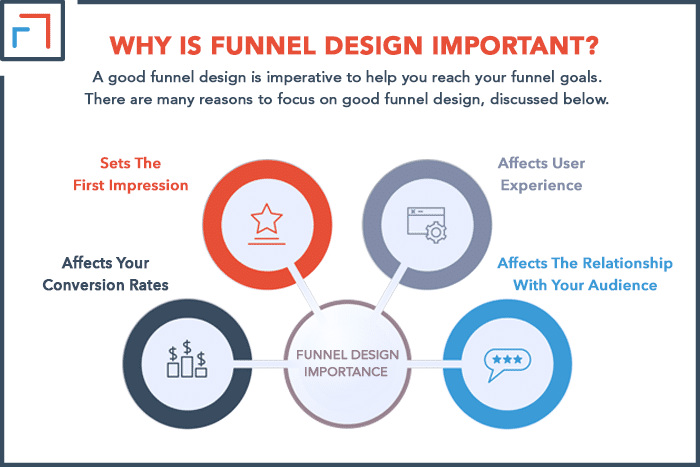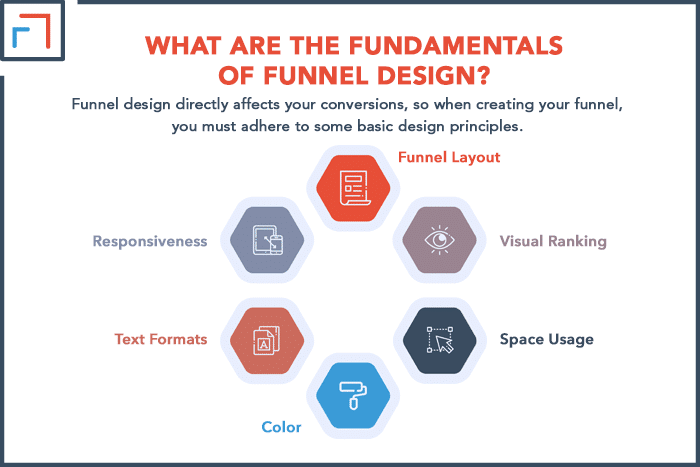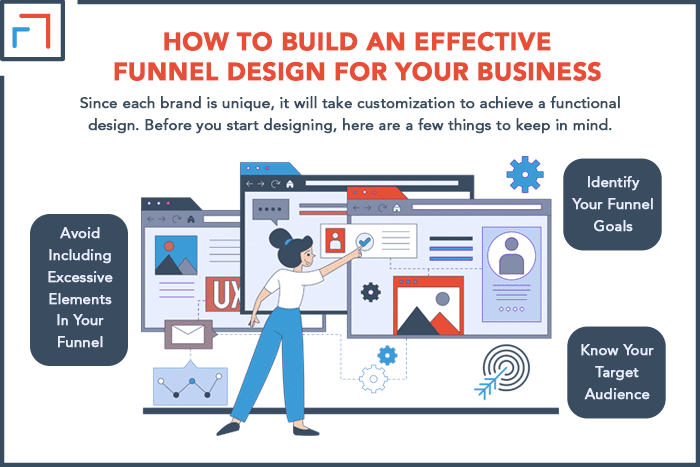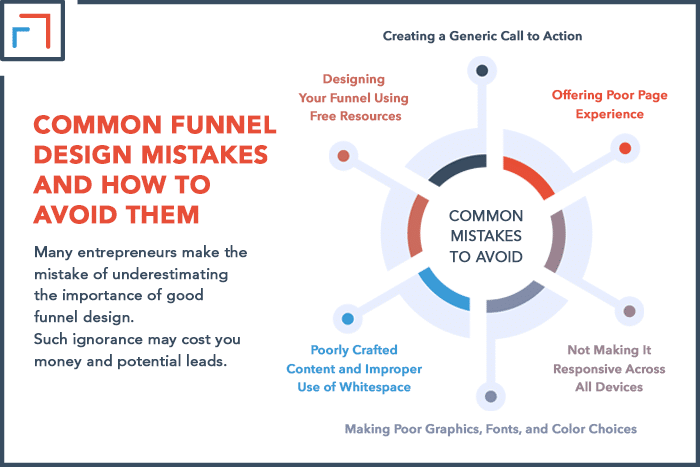Creating a successful sales funnel requires you to consider various funnel design elements. Most importantly, you need to remember that your funnel design can make or break your conversion rates. Therefore, you need to consider how your design will benefit the funnel in the end.
Funnel design is important because it affects your conversion rates, the user experience, and your relationship with your audience. Additionally, it creates the first impression about your business. Good funnel design helps leads to trust you, stay on your page longer, and take the desired actions.
In this post, we will discuss why you should have a good funnel design, how to properly design your funnel, and some common funnel design mistakes to avoid. Read on to learn how to design and improve your funnels!
Importance Of Funnel Design
A good funnel design is imperative to help you reach your funnel goals.
Therefore, the way you design your funnel can affect your marketing or sales goals positively or negatively.
There are many reasons to focus on good funnel design, and we’ll discuss each of them below:
1. Funnel Design Affects Your Conversion Rates
A proper funnel design can help users easily find what you want them to see.
For example, you can design your funnel pages to emphasize special elements such as limited-time offers, calls to action, and other clickable elements.
When these elements are easy to locate, they drive users further down the funnel by prompting them to take action.
On the flip side, poor design overwhelms users and leaves them confused. Subsequently, they will not take action. This results in a low conversion rate.
2. Funnel Design Sets the First Impression
When visitors first visit your page, they will form an opinion about your brand.
If your design is unattractive and obsolete, they will perceive your business negatively. This will diminish their interest in your business.
Funnel design is essential because it influences a visitor’s perception of your brand.
The picture portrayed by your design can either get them to stay and find out more about your business or leave your page altogether.
Additionally, people can use your design to gauge how well you will serve them.
When you have a good design, visitors know they can expect good customer service.
It shows you care enough about your visitors to give them a good first impression.
3. Funnel Design Affects User Experience
A well-designed funnel with adequate steps makes it easy for users to make it through the funnel steps.
When the funnel is too long, leads may feel frustrated and overwhelmed.
On the other hand, a funnel that’s too short will provide inadequate information and will leave your leads stranded.
Similarly, adding too many elements can become distracting to your audience. Imagine landing on a page that finally seems to address your problem.
Then, just as you get comfortable, swarms of pop-ups, dancing images, chat boxes, and subscription offers fill your screen.
Worse still, they prevent you from viewing the primary copy.
While these elements are useful, improper timing and positioning will frustrate your visitor and force them out of the funnel.
4. Funnel Design Affects the Relationship With Your Audience
Your funnel is like your spokesperson. So, if your funnel is poorly designed with outdated graphics, it will be difficult to trust your brand.
A poor design also makes your page look unprofessional.
The secret to building a good audience relationship is by striking a balance between your goals and the number of funnel steps needed to achieve them.
Don’t add too many steps because they may feel like a hard sell. In addition, be sure to use modern designs.

What Are the Fundamentals of Funnel Design?
Since funnel design directly affects your conversions, it is important to design your funnel properly.
When creating your funnel, you must adhere to some basic design principles. Here are the basics to guide you:
1. Funnel Layout
The way you arrange your funnel elements plays a major role in the success of your funnel.
When arranging your funnel pages, ensure you lay them out in a way that works together harmoniously.
This will help your page visitors to transition smoothly from one step to another.
Furthermore, keeping disorganized funnel elements will make your work look unprofessional and confuse your leads.
As a result, they will not make it to the next step in your funnel.
2. Visual Ranking
The visual ranking reveals the order in which a visitor will view your page elements. Of course, your page elements do not all have the same priority.
The visual hierarchy needs to emphasize the funnel elements that you need to be viewed most.
In this case, using design elements such as color schemes will come in handy.
For instance, if a call to action is more important than other elements on a page, use a brighter, eye-catching color on the buttons.
This will make the CTA stand out from the other elements.
3. Space Usage
Another funnel design principle is the use of white space. Also referred to as an eye break, the blank white space on a page makes the text more readable.
However, leaving too much or too little space can mess up your funnel design in a big way.
It is tempting to add several fancy elements to your page, but the end result is a confused user who will not take any action.
So, the key is to balance the negative space and the page elements so you can emphasize the most important ones.
4. Color
Color is another crucial design element that is often overlooked.
Aside from representing your brand identity, colors have the ability to elicit certain emotions in people.
This means you need to select your funnel colors with the user in mind.
For instance, studies have shown that using a red call to action button gets more people to take action compared to a green one.
5. Text Formats
A good design is much more than just using your favorite fonts on your funnel.
Since different typefaces imply different feelings and emotions, you need to choose fonts with user intent in mind.
In addition, you need to choose legible fonts. A good copy will be less impactful if a reader has to squint to read it.
Obviously, no one will be willing to buy from you if they struggle to read what is on your page.
6. Responsiveness
Responsiveness is a crucial element of design, given the widespread use of mobile devices.
Therefore, your funnel design should promote accessibility from a wide range of devices, including smartphones, tablets, and desktops.
A responsive design facilitates a good user experience. As a result, leads can stay on pages for longer, engage with your brand, and take action.

Building an Effective Funnel Design for Your Business
When it comes to funnel design, there isn’t a one size fits all strategy that can be applied to every business.
Since each brand is unique, it will take customization to achieve a functional design. Before you start designing, here are a few things to keep in mind
1. Know Your Target Audience
Keeping your target audience in mind while designing your funnel is crucial.
Each audience group has different needs and interests that your design should cater to.
For instance, using cartoon graphics would resonate with an audience of children but not adults.
To better understand your target audience, conduct some research to understand their pain points and how you can best help them.
You can also create lead forms to help you gather data from your prospects and customers.
2. Identify Your Funnel Goals
How you design your funnel also depends on the goals you intend to achieve. This is because different goals require different designs.
The goals will help you create a funnel that reflects the objects in every step.
For instance, if your goal is to promote a product, then your design should feature the benefits or features of the product.
Or, if your goal is to get more people to sign up for your services, your funnel design should make it easy for people to learn more and sign up.
3. Avoid Including Excessive Elements in Your Funnel
Keep your funnel steps concise and to the point.
For instance, adding too many elements like links, top navigations, and unnecessary images may sway your visitors from the core objective.

Common Funnel Design Mistakes and How to Avoid Them
Many entrepreneurs make the mistake of underestimating the importance of good funnel design. It plays a major role in the success of any marketing strategy.
Unfortunately, such ignorance may cost you money and potential leads.
There are many things you can do to encourage sales, but there are also some common mistakes you should avoid at all costs.
1. Creating a Generic Call to Action
A call to action is an important page element that gets your audience to take action. However, it is common to create CTAs just for the sake of it.
Nowadays, most consumers expect a personalized experience.
A personalized CTA speaks directly to leads and triggers their emotions in order to help them take action.
To design a personalized call to action, avoid generalized messages such as ‘Contact Us.’ Additionally, use personal words like you, your, or my.
Be unique and creative as well!
2. Offering Poor Page Experience
Page experience shows how users perceive and regard your funnel.
If you offer a poor page experience that makes it difficult for visitors to navigate your page, they will drop out of your funnel.
Similarly, funnel drop-offs may lead to abandoned carts and a loss in revenue.
To improve the page experience of your funnel, start by optimizing your funnel pages to load faster.
You can increase page load speed by uploading smaller photos, limiting redirects, using a CDN, etc.
Another way to improve page experience is by minimizing intrusive pop-ups that occupy the whole screen.
This is especially important on mobile because the screen is smaller. Finally, let your users know your pages are secure by using the HTTPS signal.
3. Not Making It Responsive Across All Devices
Another common funnel design mistake is prioritizing desktop versions more than mobile versions.
In reality, more web visitors use phones and tablets instead of computers. As a result, ignoring mobile user-friendliness puts your funnel at a disadvantage.
You will lose out on traffic as well as potential conversions.
Therefore, a responsive design should make your funnel work well and look great when accessed from any device.
Ultimately, remember to use mobile-friendly templates when designing your funnel.
4. Making Poor Graphics, Fonts, and Color Choices
Another common yet costly funnel design mistake is making a poor choice in terms of graphic design.
It may be tempting to skimp on graphics by choosing outdated images, poor fonts, and unconventional color schemes.
While it may save you time, it will repel visitors from engaging with your funnel.
A visually appealing design creates a good impression of your funnel and makes your brand appear reputable.
In turn, users find it easier to trust your brand. Therefore, it is crucial to choose your graphics, fonts, and colors wisely.
Here are ways to avoid making graphic design mistakes on your funnel:
- Use a minimalist design that balances the number of visuals and page content. It should be readable and easy to comprehend.
- Don’t use too many colors on your pages. Aim for a maximum of four colors that your target audience will likely enjoy.
- Use graphic visuals that reflect the tone and general emotion of your brand.
- Use appropriately sized fonts that are legible so your readers won’t struggle to read your message.
5. Poorly Crafted Content and Improper Use of Whitespace
Most readers do not take the time to read through all of your content. They usually skim through, and a poorly crafted copy is difficult to skim.
Moreover, improperly using the whitespace around your text makes it appear as a large block of text. This makes it difficult to read.
When your funnel visitors find it hard to read your message, they will leave your funnel.
Fortunately, you can adequately utilize your white space and write readable copy with the following tips.
- Use paragraphs, headings, and bullets to break down blocks of text.
- Keep your copy clear and concise yet informative.
- Balance your page elements against the white space to achieve a neat and professional look.
6. Designing Your Funnel Using Free Resources
Although using free funnel building software can save you some money, they can only take you so far.
Free tools often come with design limitations, such as unattractive graphics and limited editing capabilities.
To avoid this problem, choose a quality funnel-building software with resources that best suit your funnel design needs.

Final Thoughts
Proper funnel design is crucial to the success of your business.
A good design provides a good user experience, gives a favorable impression, fosters trust, and ultimately boosts conversion rates.
This is because good design helps users transition smoothly through the funnel steps.
To create a good funnel design, keep in mind the design principles, such as high-quality graphics and the proper use of white space.
In addition, avoid common design mistakes such as not optimizing your design for mobile.
Now that you know the importance of funnel design, you can improve your current and future funnel designs using the tips above.
